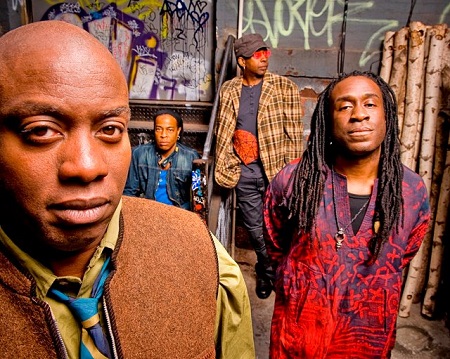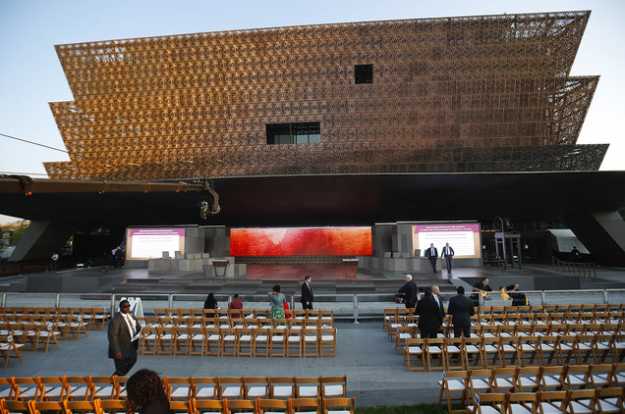|
Taken from Billboard (Sep 26, 2016)
Living Colour Talk Upcoming Album ’Shade’ & Role in Smithsonian’s Newest Museum
by Cathy Applefeld Olson

Living Colour |
The National Museum of African American History & Culture opened on Sept. 24.
For more than three decades, rockers Living Colour have never shied from sharing their perspective on the African-American experience. Hanging backstage before Saturday’s (Sept. 24) Freedom Sounds concert for the National Museum of African American History & Culture, members Vernon Reid, Corey Glover, Doug Wimbish and Will Calhoun were visibly humbled by their role in the museum’s opening.
“That building right here, right now -- we’re here because people paid the cost,” says guitarist Reid. “People that people don’t even know about. They could play their asses off but they never got discovered. It never, ever leaves us that people paid the cost. That’s in our DNA. We don’t pretend that we don’t know.”

Pablo Martinez Monsivais/AP/REX/Shutterstock
The Smithsonian Museum of African American History and Culture photographed on Sept. 24, 2016 in Washington, DC. |
Reid, who founded the Black Rock Coalition in 1985 to promote creative freedom among black musicians, says the band’s place in the museum’s extensive music exhibit is “an acknowledgment of a continuum. Part of the argument of this band through our whole career is that rock’n’roll is not white music. There’s a narrative that says, ‘Yeah, black people started it and white people took it over and that’s it.’ That’s a premise I’ve always rejected.”
Referencing a lineage of acts including War and Parliament Funkadelic, singer Corey Glover adds, “There’s a supposed gap between when Hendrix came along and left, in the late ‘70s, early ‘80s where they said there were no black rock bands. They were there, they were just being called something else.”
From the get-go, the band’s debut album Vivid packed a parcel of keenly observant, emotionally charged songs. “One of the things that’s awesome, and also terrible, is how relevant our music continues to be,” Reid says. “A song like ‘Funny Vibe’ or ‘Ignorance Is Bliss’ or ‘Which Way to America’ – We’re still talking about the two Americas.”
It’s a conversation that needs to continue, says drummer Calhoun. “I hear people say 'Black lives matter,' that’s winding things up,” he notes. "When I hear white people say, 'White lives matter,' of course they do. But white people weren’t getting strung up on trees, white people’s houses weren’t getting burned down.”
An urgency to address the rampant police shootings and gun violence spurred the band to record the Notorious B.I.G. song ”Who Shot Ya” this summer, with an Andre Betts remix featuring Black Thought, Chuck D and others. The song will be included on the band’s forthcoming album Shade. “It was prescient, what he was saying,” says Glover of the Biggie original. “We could go back as far as there have been guns and talk about somebody without one being shot by somebody with one.”
“I did a lot with hip-hop. All the Sugar Hill stuff, there were a lot of weapons around all the time," bassist Wimbish says. “Working with the Boo-Yaa Tribe -- [there were] weapons and gang violence. But the reality is, it affects everybody.”
The four members also feel a responsibility to do their part of make sure current and future generations know the history of black Americans. “I saw the Civil Rights movement, I was a witness of what that was all about,” says Wimbish -- who was six years old when his father boarded a train from the family’s home in Hartford, Conn., to be part of Martin Luther King Jr.’s 1963 March on Washington, and to document the historical event via extensive photos. “When I got here and heard [President] Obama speak… I couldn’t hold the tears back. I remember taking my father to the station and not understanding at that age what the significance was. The generation now -- not all but some -- they’re not really interested in it, it’s almost like ‘That was your history.'”
“It may not be happening in your sphere, but it is happening,” adds Glover. “What goes on at the museum and what goes on 30 blocks from there -- we have an obligation as artists to put [up] a mirror. If we can show people, and have what they think they know reflected back at them, maybe they’ll get a little chance to make a difference.”
The history on display at the Smithsonian’s newest museum is important to this younger generation, says Reid, because “they’re going to be affected by it. You have to have the conversation about what actually happened and the impact of it, because they’re going to be affected by it. There’s no getting around it.”
|